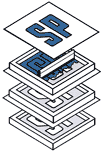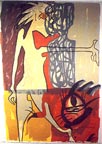Screen Print

The screen with
stencil in place,
paper positioned,
printing taking place
& the finished print.
To produce a Screenprint, a fine woven mesh (originally made of silk, but today made from synthetic materials) is stretched tight over a frame.
Stencils are used to mask out the areas of the screen that are not to be printed. There are many ways of making a stencil, from simple paper cut-outs, to light sensitive emulsions, on to which photographic images can be projected.

For a more ‘painterly’ effect, a PVA based gum called ‘blue-filler’ or ‘blue block-out’ can be painted directly on to the screen. Even melted wax and wax crayons can be used to draw straight on to the screen.
A sheet of paper is laid under the screen, then a flat rubber blade called a squeegee is drawn over it, forcing ink through the open areas not masked by the stencils.
The Complete edition is printed in the first colour before proceeding to the second stencil, and printing, ensuring that the colours fit one upon another.
This process is continued until the image is complete. Additional colours can be achieved by using transparent inks and over-printing one colour with another, thereby producing a third colour
The screen print is characterised by its uniform layer of colour and is an ideal medium for a design with large areas of flat colour.